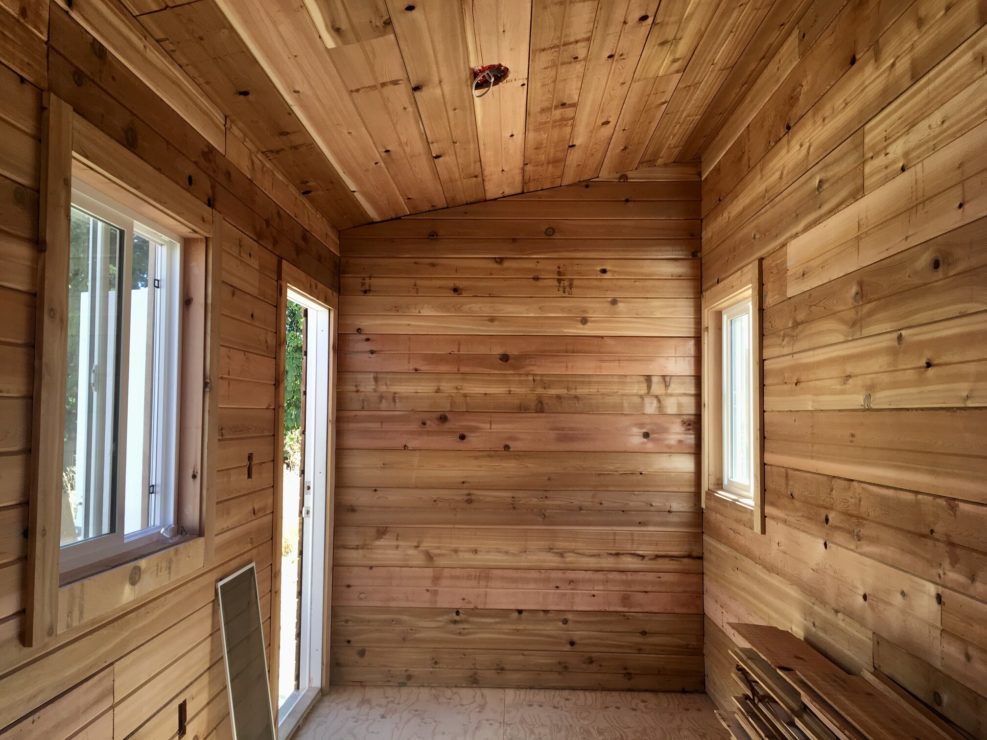Grizzly Den to serve as mobile trapping cabin and access point for Indigenous land defenders

From August 8 to 14, community members gathered downtown to work on an annual tiny house build to support Indigenous sovereignty and resurgence.
This year’s build focused on the Wet’suwet’en peoples ongoing struggle against Coastal GasLink — a natural gas pipeline being built on their traditional lands in northern B.C. without consent from hereditary chiefs. The tiny house will serve as both a mobile trapping unit for Wet’suwet’en people and a base for land defenders. As in past years, the build played host to a series of talks. Topics this year ranged from street medics to the Black Lives Matter movement.
Unique Circumstances
This year’s tiny house build took place under unusual circumstances. With the COVID-19 pandemic still ongoing, organizers were forced to limit the number of volunteers at the Balmoral Road build site.
“We had to control the space because of COVID and other builds there have been tons and tons of people in and out of the space,” said Gina Mowatt, one of the organizers of the build, in an interview with the Martlet.
Mowatt said that the maximum number of people working on the house at any one time was 10, with two shifts taking place each day in the morning and the afternoon. She said that despite this limitation, physical distancing measures allowed around 100 people to wander in and out of the site over the seven days of the build and accompanying workshops.
Building Community
Mowatt says that the goal of these builds is not only to provide support for Indigenous peoples fighting against colonialism and land appropriation, but also to build a local sense of community and create awareness about other issues — such as lack of affordable housing and racism in the wider Victoria area.
“Part of the importance of these projects is that we’re trying to raise consciousness, awareness and creating space for people to come and learn, and give people access to information that otherwise is only accessible if you’re university students,” said Mowatt. “Obviously, we’re unified in coming together to support Indigenous land defenders, but it’s also so important to look at the other intersecting issues and build awareness around those.”
Eight talks were given over the course of the build. The first was given by two Indigenous women, Kati George-Jim and Tiffany Joseph, and focused on how individuals can build strategies around relationships, consent, and identity.
Later in the week, Rita Kaur Dhamoon gave a talk on allyship, while UVic professors Sarah Hunt and Chaw-win-is spoke about how settler colonialism operates and steps to retake sovereign control. Other speakers talked about the Black Lives Matter Movement and Oaklands Anti Police-Terror Project. Street Medic Bee also discussed first aid techniques and Shae Perkins of AVI carried out Naloxone training.
“We just had an array of speakers and we had it outside, we had people socially distant, but we had a great turnout every single night,” Mowatt said.
All Eyes on Wet’suwet’en
In previous years, tiny houses were sent to the Tiny House Warriors to help Indigenous land defenders block the Trans-Mountain Pipeline from crossing unseeded Secwe̓pemc land. Last year, houses were given to the Ma’amtagila Matriarchs to help protest against illegal fish farming on their territories.

Due to the ongoing Wet’suwet’en struggle against the Coastal GasLink pipeline, organizers decided that this year’s tiny house would be for the use of Wet’suwet’en land defenders, specifically the Gidimt’en clan, whose territory is where the house will be placed. The name of the house, Grizzly Den, represents the Gidimt’en as the Grizzly Bear House of the Wet’suwet’en.
Mowatt says that the house will be used for land defense, but also traditional activities such as hunting and berry picking which aren’t accessible without places to stay.
“Due to … ongoing colonization and effects of that, Wet’suwet’en people and Indigenous people in general don’t have access to their own territories,” said Mowatt. So [the house is] going to act as a base for Wet’suwet’en people to be able to go out onto the yintah, onto their territory and connect to the territory.”
At the time of writing, the build had raised just under $16 000 of its $18 000 goal. Mowatt says that this was more than enough to cover the cost of the build, and that any extra funds raised will go towards legal funds for Wet’suwet’en land defenders. She’s also been blown away by the community support the project has received, especially in the economic downturn brought on by the pandemic.
“It’s been amazing to raise that much money, especially during the economic climate that we’re in because of the pandemic,” Mowatt said. “It’s good to see that people are still really aware of the political struggle the Wet’suwet’en are facing and wanting to support it.”
Despite the success of the build, Mowatt says that it is still important for people to remember that the Wet’suwet’en’s struggle is ongoing and they continue to face harassment from the RCMP, Coastal GasLink, and white community members. Recently, a cabin belonging to Wet’suwet’en Hereditary Chief Gisday’wa was burned down in a suspected arson attack.
“I think it’s just important for people to remember that we need to keep our eyes on the Wet’suwet’en struggle and support them as they continue to resist the colonial violence that is the Coastal GasLink pipeline,” said Mowatt.






